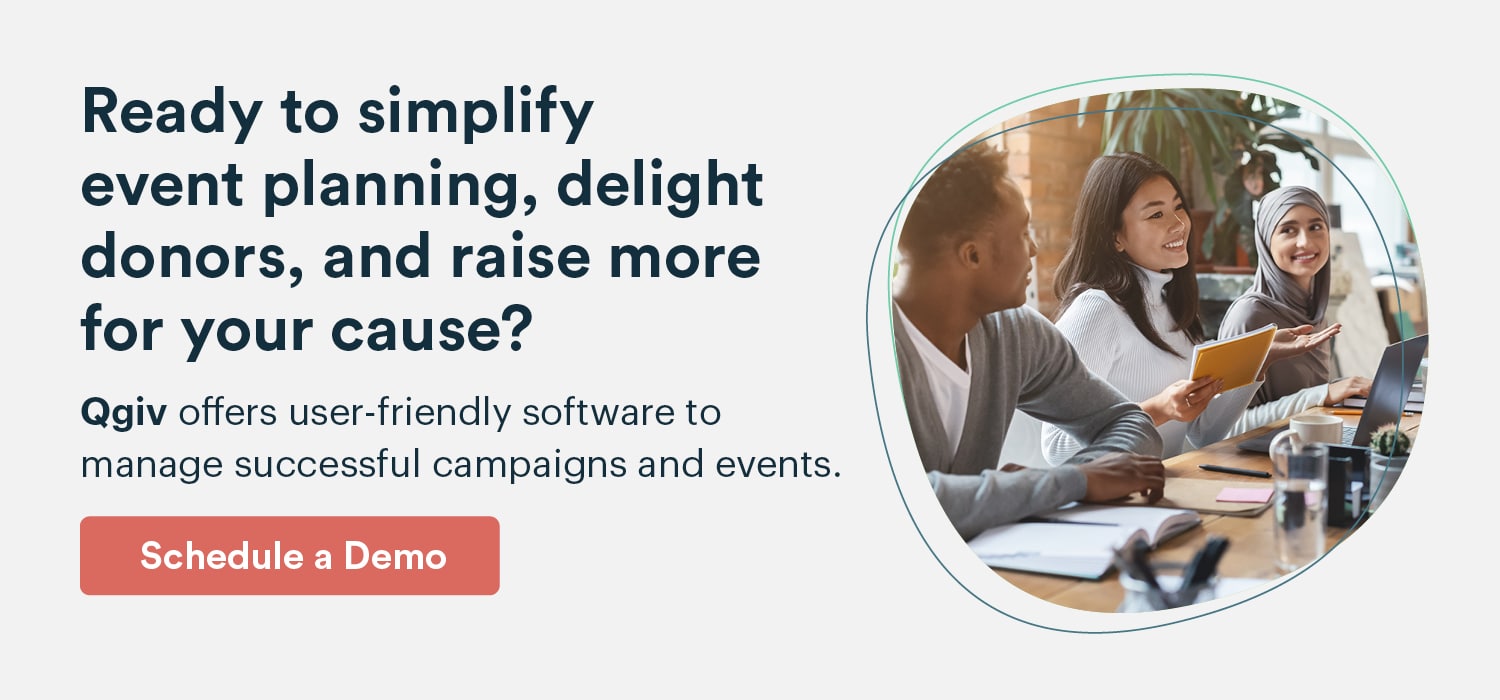What is a Silent Auction? What Nonprofits Need to Know

Fundraising statistics show that 81% of nonprofit donors attend fundraising events. Events are a spectacular way to engage with supporters, spread awareness of your programs, and boost revenue for your mission. Silent auction events can be particularly effective for driving fundraising and mission awareness.
In this guide, we’ll explore what nonprofits need to know to host a successful silent auction fundraiser. We’ll cover:
- Silent Auction: FAQs
- Best Practices to Run a Successful Silent Auction
- Top Auction Software Solutions
Silent Auction: FAQs
What is a silent auction?
A silent auction is a fundraising event at which items for sale are displayed for attendees to browse, place bids on, and purchase. However, unlike traditional or live auctions, there is no auctioneer present. Instead, participants place their bids silently and anonymously on a bid sheet using a bidding number—hence the name silent auction.
Why host a silent auction?
Nonprofits use silent auctions to fundraise in an engaging way. Rather than simply soliciting donations, hosting a silent auction allows donors to actively participate in an event and maybe even make an exciting purchase. Additionally, because the items being auctioned have been donated to the organization, the nonprofit does not lose any money in procuring them, promoting a high return on investment (ROI).
How does a silent auction work?
Silent auction attendees spend the first part of the event checking out the items for auction. When they find something they’d like to bid on, they use their bidding number to make an anonymous bid on the sheet in front of the item.
At most silent auctions, there will be a minimum bid amount and a minimum increase requirement. The minimum increase requirement dictates how many dollars more a bid must be than the last. Once the bidding has ended and the winning bids have been announced, winners can complete their transactions and collect their items in a checkout area.
How do you run a silent auction?
Like any event, running a silent auction takes careful planning. Here are some considerations organizations should keep in mind when planning and running a silent auction:
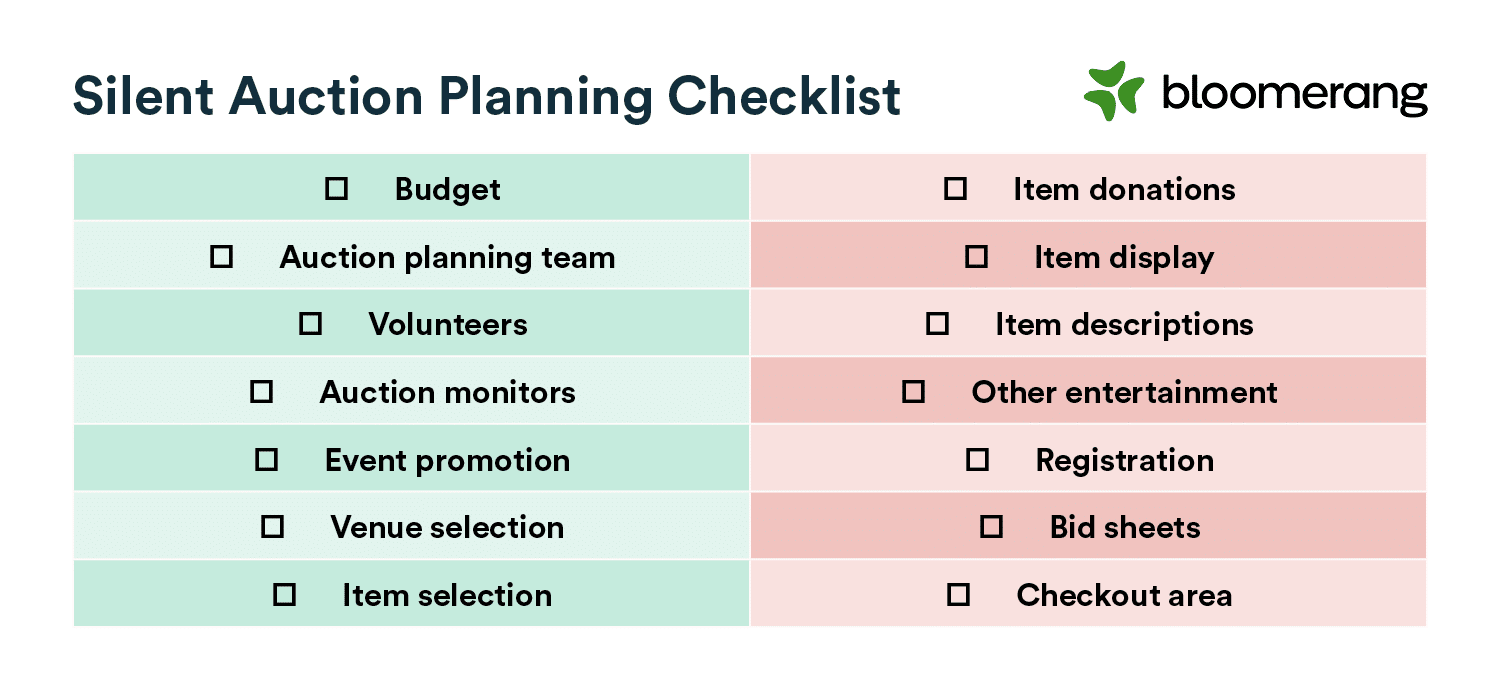
- Budget. Although you’ll ask for partners to donate auction items, there are other costs you’ll have to consider, such as venue rentals, entertainment fees, staff time spent planning the auction, catering, and other event supplies. Outline and stick to your budget as you plan your event.
- Auction planners. A silent auction event needs a strong team to be successful. Along with an auction chair, it’s helpful to have someone in charge of event logistics, item procurement, promotion, and volunteer management.
- Volunteers. Recruit volunteers to help set up, manage registration, check out attendees, and handle other tasks that require extra help.
- Auction monitors. Assign a few experienced staff members to act as event monitors to ensure the auction runs smoothly. Because all of the bidding is done by the attendees themselves, the auction monitors’ main responsibility is to check that everyone follows the rules and guidelines.
- Event promotion. Event marketing should start as soon as the date is set. Promote the event using email newsletters, social media posts, blog posts, and direct mail invites. Consider teasing available items in your communication or sharing photos of the previous year’s event to spark interest.
- Venue selection. When choosing the venue, remember to prioritize traffic flow. Guests should be able to move about freely without feeling cramped or cornered. There should also be plenty of space for display tables, high tops, and serving stations for food.
- Item selection. Consider the audience before procuring items. Are they seniors? Young singles? Academics? Thrill seekers? Select items attendees will be excited about. If your auction has a theme, also choose items that make sense for your theme. For example, if the theme is Winter Wonderland, you might choose items like a hot cocoa basket, ski lodge passes, and skiing equipment.
- Item donations. Ask corporate sponsors or major donors if they’d be willing to donate valuable items to your event. Inspire a stronger connection to your event by explaining the purpose of your auction and describing the programs or projects the auction will help fund.
- Item display. Make sure all items are visible. Use stands, platforms, stages, and easels to make items stand out.
- Item descriptions. Create item description sheets that include details about the item, who donated it, why it’s valuable, and anything else you think the buyer may want to know.
- Other entertainment. Consider other entertainment you might feature at your event while attendees walk around to bid on items. This could include a DJ, live musicians, or a photo booth.
- Registration. Registering participants is not required, but it does offer a few benefits. First of all, it allows the bidder to be anonymous. After participants fill out the registration form, they will receive a bidder number which they can use to place bids instead of using their names. Registration also ensures you get contact information from every attendee should you need to get in touch with them after the event.
- Bid sheets. When a participant wants to bid on an item, they will jot down their bidding number and their bid amount on the bidding sheet in front of the item. Some sheets also include a “Buy Now” price for attendees who have their hearts set on the item.
- Checkout area. Designate a specific space for checking out, where the winning bidders can claim their items and pay for them.
By keeping all of these factors in mind, you can plan an event that wows attendees, encourages more donations, and keeps supporters coming back year after year.
How does an online silent auction work?
Online silent auctions allow you to save on overhead costs like venue rentals and catering. Plus, because these auctions take place virtually, the bidding period is usually longer than an in-person auction. Some accept bids for a few days, while others accept them for a few weeks. This gives supporters more time to browse your items and decide what they’d like to bid on.
Online auctions are also an important feature when in-person gatherings are not feasible. Moving to the digital space can break down geographical barriers, opening your silent auction to more donors.
The most important step in planning an online silent auction is choosing auction software. Participants will register, make bids, and pay for items all through the auction site. Organizations are still responsible for soliciting the items, taking pictures of the items to display, and setting starting bid amounts.
Best Practices to Run a Successful Silent Auction
Every silent auction is different depending on the theme and fundraising goal, but there are a few key best practices most of them follow:
- Advertise some auction items ahead of time. Provide a sneak peek at the items up for bidding using social media posts or email newsletter teasers. Don’t reveal every item that will be available, but highlight a select few to generate excitement and get attendees thinking about what they might like to bid on.
- Establish a closing time. Guests should have a specific, predetermined length of time within which they may place bids. This creates a sense of urgency and ensures guests place bids on items they are interested in as soon as possible. If multiple events are happening at the silent auction, like a sit-down dinner, consider closing bidding before the dinner so that guests’ attention is not pulled in too many different directions.
- Have an appropriate number of items available. Experts suggest having no more than one item for every two people at your event. Having too many items is overwhelming for guests and won’t necessarily increase the number of items purchased.
- Leverage mobile bidding software. Mobile bidding software allows supporters to conveniently place bids using their mobile devices, whether you’re hosting a virtual or in-person event. You can also use this software to stay in touch with attendees during the event and send push notifications for when they’ve been outbid or when the bidding is about to close.
- Control traffic flow. Arrange tables in a way that makes all items easily visible and avoids traffic jams. Traffic should move as quickly and efficiently as possible.
- Organize items strategically. Items should be organized from least expensive to most expensive. If you place the more expensive items at the start, bidders may only choose to bid on one item instead of placing multiple bids on less expensive items.
- Show gratitude to supporters. Emphasize your appreciation for event attendees both during and after the auction. Have your event emcee thank supporters for attending and remind them about what their donations will support. After the event, send thank-you emails personalized with supporters’ names and references to their donation amount.
- Demonstrate the impact of the event. In your follow-up messages, share the total fundraising amount from the event and how your nonprofit will put donors’ gifts to good use. Describe the specific impact of their gifts. For example, you might say “Your incredible and tireless support raised $100,000 to fight childhood hunger in our community. Because of your generosity, families in need will be able to access free meals all year long!”
- Ask attendees for feedback. To make your next auction event even better, ask attendees for input about their experience. Send a survey the day after your event to ask for their opinions on everything from the registration and bidding process to the quality of the items available. You’ll not only be able to gather valuable information to keep in mind for your next event but also show supporters that you care about their opinions and want to plan events that appeal to them.
Consider your auction event as not just a fundraiser, but an opportunity to forge stronger bonds with supporters that bolster your mission over the long term.
Top Auction Software Solutions
Leveraging an auction software solution will help streamline the planning process, make registration and bidding simple for attendees, and allow your nonprofit to track valuable event data. Here are the top options available for nonprofits.
Qgiv
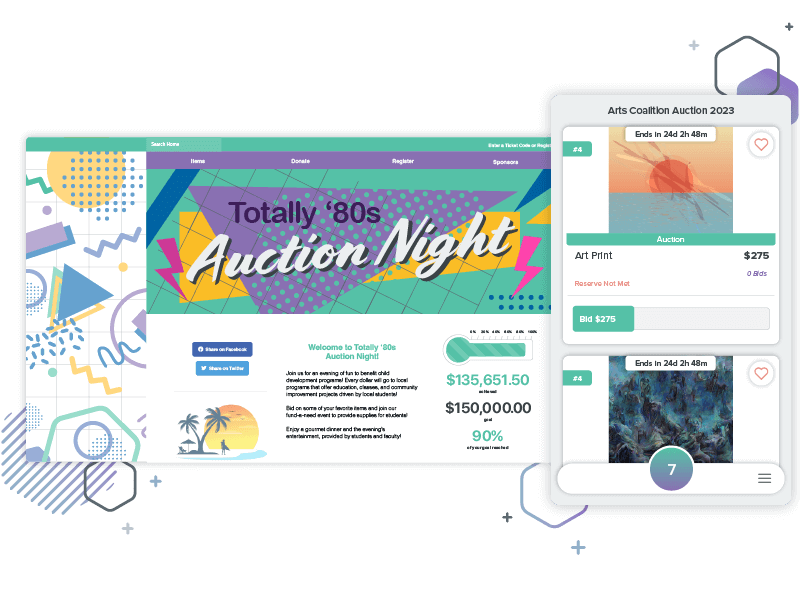
Qgiv’s auction software makes silent auction planning and mobile bidding a breeze. Event planners can create branded pages for virtual, live, and hybrid silent auctions. Mobile bidding allows supporters to download an app and easily bid on items right from their phones. Real-time push notifications will let them know when they’ve been outbid, keeping them tuned into your auction.
Additional stand-out features of Qgiv’s auction platform include:
- Simple drag-and-drop venue planning features to help determine the best layout for your auction
- Ability to accept additional donations during the registration process
- Simplified checkout where guests can view all purchases in a single transaction
- Reporting features allowing you to view all data in a single, customizable dashboard
Qgiv is the leading auction platform because it enables unlimited auction events, easy item setup, and stress-free event planning. Plus, free support features ensure that all fundraisers have the training and resources they need to create successful events. Request a demo today to learn more about this solution.
Handbid

<Handbid equips auction planners with a user-friendly app available on the Apple Store and Google Play. Plus, supporters can also easily bid from the desktop version of your customized auction event site. Using Handbid Live, you can stream a live video feed to engage supporters and offer an additional engaging virtual element to the experience.
CharityAuctionsToday
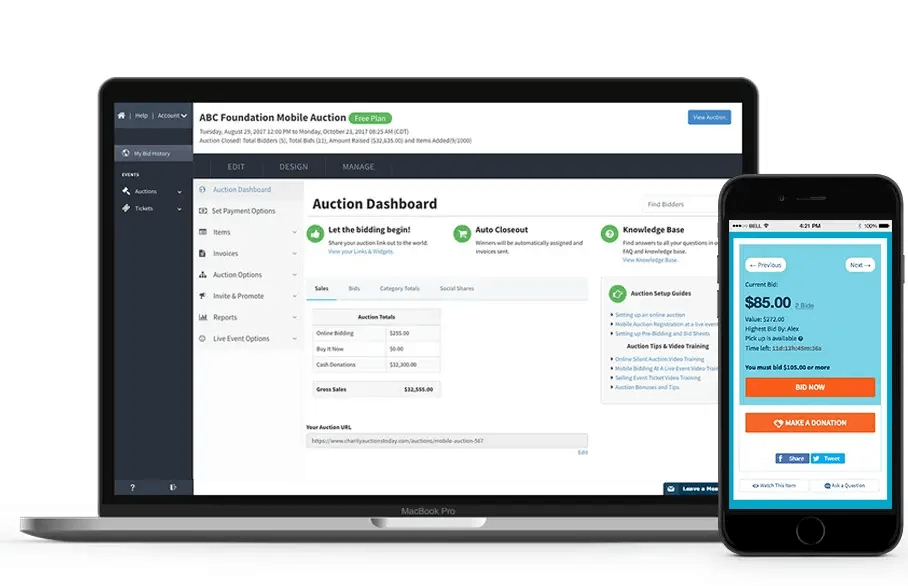
CharityAuctionsToday offers auction software that helps event planners get their events up and running in just minutes. The auction platform works on all devices, allowing participants to make bids from anywhere. CharityAuctionsToday also partners with Stripe, PayPal, WePay, and other top payment processors to offer a seamless checkout experience.
CausePilot
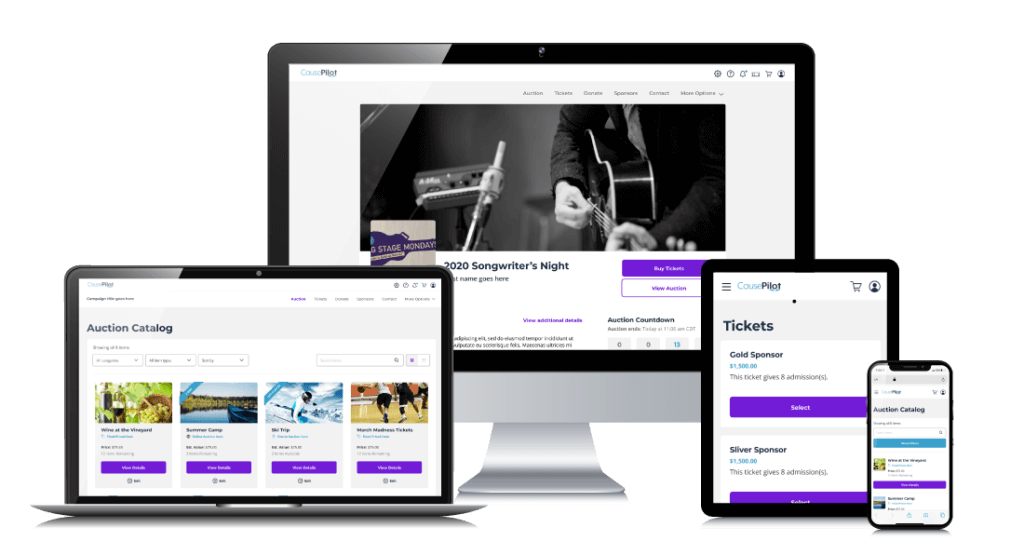
CausePilot offers auction software for organizations looking to plan events on a tighter budget. They offer a free plan with a 5% usage fee for small and growing nonprofits. This auction platform’s features include volunteer management tools, a procurement tool to solicit items easily, and a seamless checkout process using one-click auto checkout.
OneCause
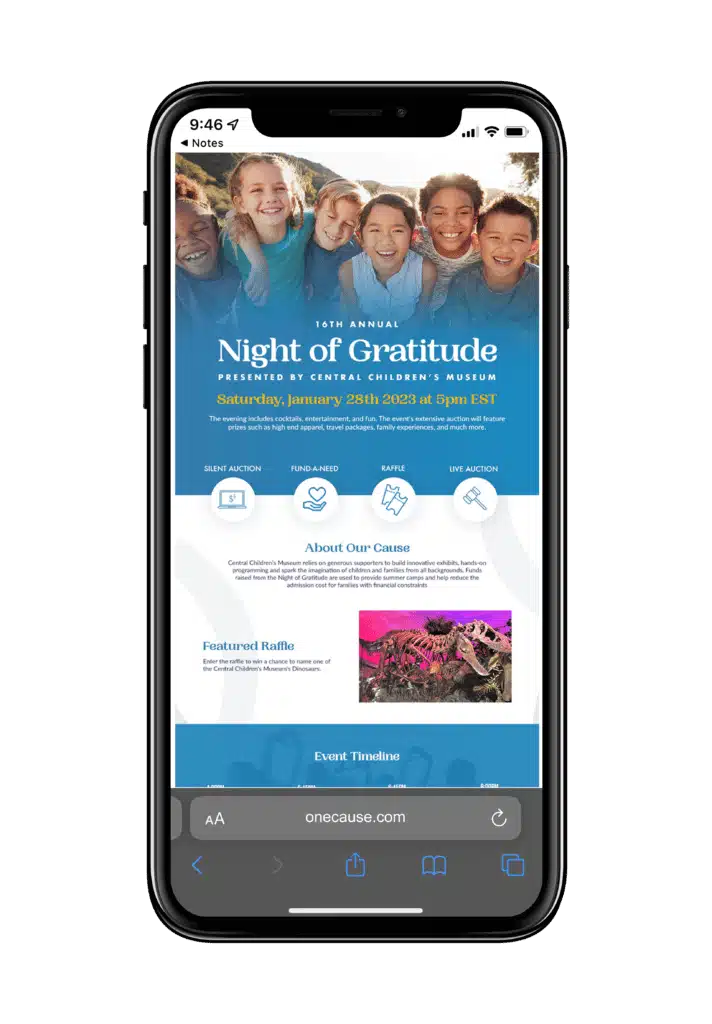
OneCause also offers convenient mobile bidding options as part of their powerful auction software. OneCause simplifies ticketing and table management, allowing auction planners to create customized ticket packages. Plus, you can keep donor management at the forefront with access to real-time donor engagement analytics.
Bloomerang
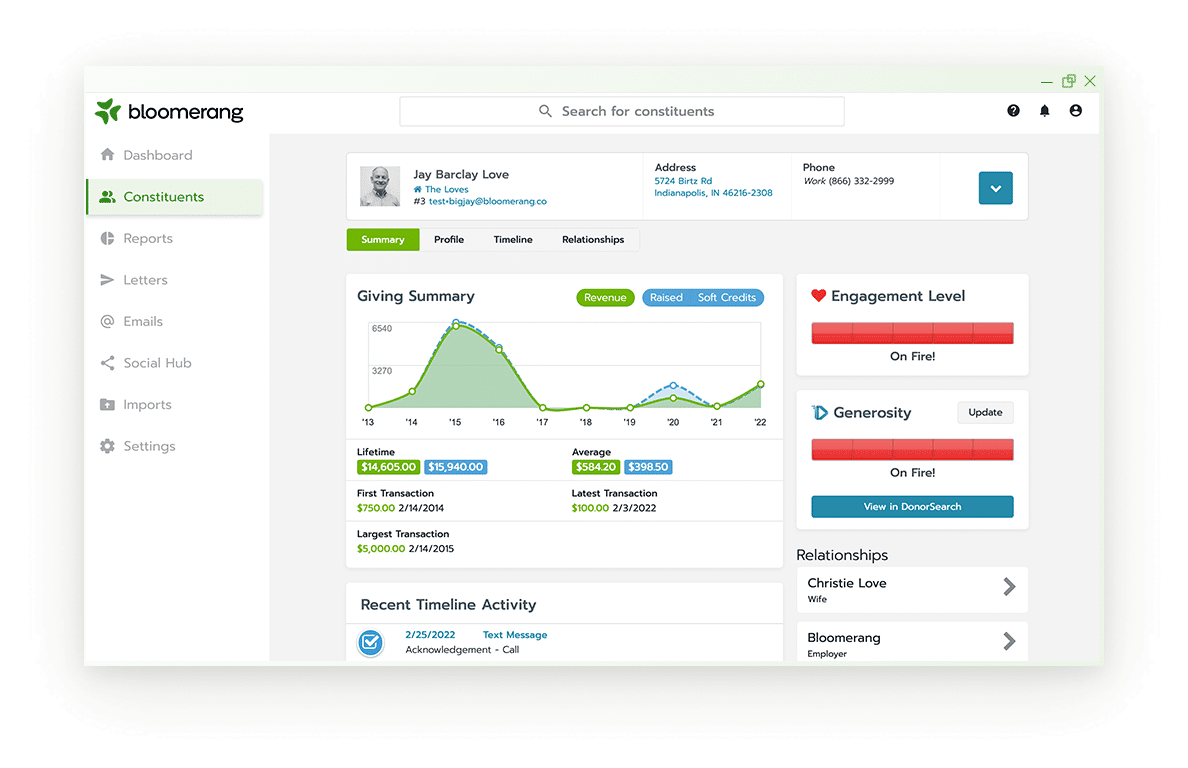
Although Bloomerang is a donor management system, it offers plenty of features that make the auction-planning experience a breeze. Bloomerang’s event fundraising tools make it easy to create and promote online registration forms and track data collected through those forms in your CRM. Bloomerang’s donor database automatically spotlights your most engaged donors based on their past interactions, making it easy to identify supporters to invite to your auction.
Plus, Bloomerang partners with top auction solutions like Handbid and Qgiv. Leveraging the Handbid integration, Bloomerang users can easily sync auction and supporter data across systems. With Qgiv, you can build a customized auction event page and allow participants to engage using an app or website. Learn more about this partnership here:
Leveraging an auction platform that’s integrated with your donor database ensures that you won’t lose track of any attendee information and that you can send prompt thank-you messages to all participants.
The bottom line
Silent auctions are a fun, effective way to fundraise. With some planning and attention to detail, nonprofits can host an enjoyable, lucrative event. Just make sure to invest in the right software to power your event. That way, you can focus on creating an event that donors remember for years to come.
For more information about planning an auction, check out these additional resources:
- 15 Top Online Fundraising Platforms to Ramp Up Donations. Looking for an effective event management platform? Explore Bloomerang’s roundup of top virtual fundraising platforms, including plenty of auction solutions.
- Silent Auction Software: The Buyer’s Guide. Silent auction software makes it easy to manage event registrations, mobile bidding, and donor management. This guide rounds up top solutions to consider.
- Top Silent Auction Rules for Your Nonprofit’s Next Event. Clear guidelines are required for your auction to run smoothly. Here are the top silent auction rules to include in your next event.



